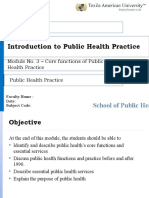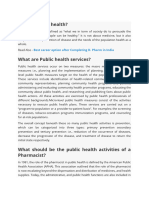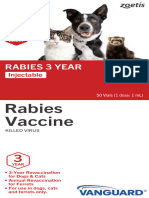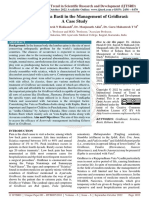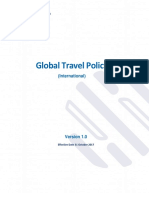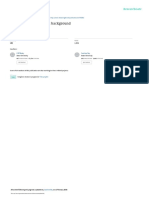Monitor Health Status To Identify and Solve Community Health Problems
Monitor Health Status To Identify and Solve Community Health Problems
Uploaded by
Zee Zeinab FarhatCopyright:
Available Formats
Monitor Health Status To Identify and Solve Community Health Problems
Monitor Health Status To Identify and Solve Community Health Problems
Uploaded by
Zee Zeinab FarhatOriginal Description:
Original Title
Copyright
Available Formats
Share this document
Did you find this document useful?
Is this content inappropriate?
Copyright:
Available Formats
Monitor Health Status To Identify and Solve Community Health Problems
Monitor Health Status To Identify and Solve Community Health Problems
Uploaded by
Zee Zeinab FarhatCopyright:
Available Formats
PACKET 3: First, a little history.
Many of you may be familiar with the core functions, which were outlined in the 1988 Institute of Medicine report - The Future of Public Health. As stated in the IOM report, the three core functions of public health are assessment, policy development and assurance. This is a good start to describing public health, but 1994, when the country was exploring issues related to health care reform, the public health sector felt that a better definition and description of public health was needed. A Core Functions of Public Health Steering Committee was convened to address this need. This Steering Committee involved representatives from Public Health Service Agencies (CDC, HRSA, Office of Disease Prevention and Health Promotion, etc.) and key National Public Health Organizations. The committee produced a statement called Public Health in America. Basically, any public health activity can fit into one of these ten categories. So for example, Essential Service #1 includes activities such as data collection, community health assessments and the maintenance of population health registries. As another example, Essential Service #7 includes personal health care services as well as transportation and other enabling services and assuring the availability of culturally appropriate personnel and materials. Since the release of the ten Essential Services, numerous initiatives have explored the utility and feasibility of these services and have found them to be a good descriptor of public health. TEN ESSENTIAL SERVICES: 1. Monitor Health Status to Identify and Solve Community Health Problems Now lets look at each of the services in more detail. This service includes accurate diagnosis of the communitys health status; identification of threats to health and assessment of health service needs; timely collection, analysis, and publication of information on healthcare access, utilization, costs, and outcomes of personal health services; and attention to the vital statistics. Motoring conditions that influence health are decentralized across the community. Data is maintained by police on crime, drug use, and traffic-related injuries. Fire departments collect information on smoke detectors, fire-related injuries, and location of toxic chemical in the community. Hospitals have discharge and emergency services data. Schools have attendance data, student immunizations data, and graduation rates. Many other system partners have important data as well. All of this data when brought together helps describe health in the community. This service informs decision-makers on health matters and supports selection of effective policy, plans and interventions to improve health. Efficient and effective use of computer and communication technology is needed to assure information is timely. 2. Diagnose and Investigate Community Health Problems and Hazards This service includes epidemiological identification of emerging health threats; public health laboratory capability using modern technology to conduct rapid screening and high volume testing; active infectious disease epidemiology programs; and technical capacity for epidemiological investigation of disease outbreaks and patterns of chronic disease and injury. This service draws heavily on epidemiology and laboratory diagnostic services. Within this service, public health and its system partners establish protocols for contact and source tracing as well as incident specific responses to address infectious disease and toxic agents found in the community. Risk assessment and hazard analysis, offered through this service, supports regulatory compliance programs and enforcement actions. Within these protocols are specific guidance on communicating information to appropriate system partners so they can take appropriate action on diagnosis and investigation findings. Communicating to the public is implemented through EPHS 4 the inform and educate service but it is informed by protocol from this service. 3. Inform, Educate and Empower People About Health Issues This service involves:
Making health information and educational resources accessible; Providing health information and education activities that shape attitudes and build knowledge necessary to reduce health risk and promote better health; Establishing health communication plans and activities that use media advocacy and social marketing approaches to shape attitudes and build knowledge; Enabling informed decision-making among individuals in making health choices and among leaders establishing health policies for the community. Maintaining health education and promotion program partnerships with schools, faith communities, work sites, personal care providers, and others to implement and reinforce health promotion programs that shape attitudes, knowledge, skills, and behaviors needed in a healthy community populations. These activities assist to empower people to make informed decisions regarding individual and community health matters. 4. Mobilize Communities to Identify and Solve Community Health Problems Community health improvement is a collaborative effort requiring: Skilled conveners and organizers, Social responsiveness (above self-interest) from community members, and System structures that link community assets and the publics will to act. One person or organization can start community change but neither can make change alone. It is critical for public health system leaders to effectively convene and organize for community actions that can improve health. Actions within the public health system that demonstrate this service are: Convening and facilitating multiple community groups to undertake health improvement work. Convener should seek to include those that are not typically considered to be involved in healthrelated matters. Mobilized groups can undertake defined preventive, screening, and rehabilitation initiatives, or support other programs activities that influence health. The building of coalition is one form or system to facilitate collaboration. Other forms exist. The key however is that structures must be maintained to support the mobilization of the community in order to draw upon the full range of community assets including people, organizations, and the physical environment that can support the improvement of health. Many broadly focused processes of community action exist across the U.S. under names like Healthy Communities, Livable Communities, and Loveable Communities. An even greater number of issue specific processes exist and are addressed under names such as Healthy Mothers and Babies, Mothers Against Drunk Driving, and many, many other collaborative groups taking action to address environmental, economic, historical, and other efforts that can improve community health and quality of life. 5. Develop Policies and Plans That Support Community Health Efforts Policies addressing specific health-related issues are public statements establishing directions individuals, organizations, or governments follow to protect and promote health. Policies are established by organizations and governments to identify consistent behaviors that are expected. Community and organization leaders have responsibility to articulate policies built on proven scientific finding and shaped by community values. Policies having negative or positive influences on health touch every aspect of community life. Safety standards that makers of automobiles and producers of electrical materials follow demonstrate policies that protect people from injury. Food handling guidelines protect people from illness. Other policy examples designed to encourage or support healthy behaviors can be identified in zoning rules. For example, zoning that requires sidewalks in new residential developments. This type of policy has influence on health by supporting the opportunity for physical activity as well as improving pedestrian safety. In addition, organizational leaders can influence health with policies that govern use of tobacco at company facilities, the availability of health insurance for employees, or facilities
and time that allow for and promote physical activity. These are all examples of health-related policies that are important for community leaders to understand and apply. How well is health-related policy used to improve health in our community? Health plans provide strategic and operational guidance on how to improved health. Plans establish a set of objectives and related actions to make measurable health improve. Community health plans are more likely to be accepted and applied if the plans are made with the active participation of those the plans affect. Establishing a community health improvement plan builds on other essential services that result in development of good community health data, use of relevant public health science in decision-making, effective community education, establishment of supportive health-related policies, and mobilization efforts necessary to bring about health improvements. Community health improvement is not limited to issues classified within traditional public health or health services categories, but may include environmental, business, economic, housing, land use, and other community issues indirectly affecting the publics health. This service represents decision-making and action to plan and measure general community health improvement. In addition, this essential service addresses more specific health plans like those that focus on preparation and response to disasters and all the human health and environmental implications resulting from disasters. 6. Enforce Laws, Regulations, and Rules That Protect Health and Ensure Safety Governmental officials form public health and other regulatory officials have responsibility to assess legal authority and effectiveness of regulations. If regulations are not based on appropriate public health science and contemporary practice standards or if there are new regulations needed to properly protect health, public health leaders should advocate for needed regulator change. The primary purpose of health-related regulation is not punishment but compliance. Public health should employ the use of education and other methods to enable individuals and organizations to comply with health and safety regulations. If there is failure to comply, it is essential that public health use its enforcement authority to protect the public. Compliance and enforcement areas for public health include sanitary codes, especially in the food industry; protection of drinking water supplies; enforcement of clean air standards; protection from toxic and physical hazards in the environment; and monitoring the quality of medical services delivered through facilities such as laboratories, nursing homes, and home healthcare agencies. 7. Link People to Personal Health Services This service (often referred to as the "outreach" or "enabling" service) includes assuring effective entry of people into a coordinated system of clinical care, especially the socially disadvantaged. This may involve identifying and addressing potential barriers related to cultural, language of materials, or staff serving special population groups. It most certainly involves providing people access and linkage to a coordinated system of personal healthcare that provides ongoing "care management," transportation services, and targeted health information to high risk population groups. The system should also ensure delivery of effective health promotion and disease prevention services within the community as well as provision of technical assistance to community providers who wish to improve or offer health promotion services. 8. Assure a Competent Public and Personal Health Care Workforce This service includes: Education and training for personnel to meet the needs for public and personal health service; Efficient processes for licensure of professionals and certification of facilities with regular verification and inspection follow-up; Adoption of continuous quality improvement and life-long learning within all licensure and certification programs;
Active partnerships with professional training programs to assure community-relevant learning experiences for all students; and Continuing education in management and leadership development programs for those charged with administrative or executive roles. Actions to achieve the intent of this service may include assessing the supply and competencies of those providing person healthcare and public health services. Assuring health workers are properly trained and recognized by licensure or other credentialing processes. Supporting access to a system for life-long learning to maintain and grow health worker competencies, including the provision of mentors who can cultivate leadership and cultural competencies within the workforce. 9. Evaluate Effectiveness, Accessibility, and Quality of Health Services This service calls for ongoing evaluation of health programs, based on analysis of health status and service utilization data, to assess program effectiveness and to provide information necessary for allocating resources and reshaping programs. Its through this service we should answer the questions Are we doing things right? and Are we doing the right things to effectively improve health? Evaluation must be seen as a consistent part of all public health work. Evaluation can be identified in many forms such as customer service feedback, quality improvement programs that examine the process of service delivery, or rigorous case control evaluation. All levels of evaluation are needed. Evaluation is needed for effective decision-making and resource allocation. It is through evaluation that we understand our improvements. 10. Research for New Insights and Innovative Solutions to Health Problems This service includes continuous linkage with appropriate institutions of higher learning and research and an internal capacity to mount timely epidemiological and economic analyses and conduct needed health services research. Public health professionals have great opportunity to develop new information needed to better understand how community health can be improved. Necessity often requires innovative solutions to the health problems State and local public health professionals face. Most of our health service advances originated from the experience and insight of frontline public health workers and confirmed in collaboration study with health researchers. Public health at the State and local level must develop the capacity to participate in and guide health services research. Linkages must be established with research and academic centers in order to stimulate and capture new insights and innovations we need to public health problems. Such research must be fully participatory with those it studies and intend to affect.
You might also like
- National Health PolicyDocument62 pagesNational Health PolicyRinku patelNo ratings yet
- Public Health Nursing: Scope and Standards of PracticeFrom EverandPublic Health Nursing: Scope and Standards of PracticeRating: 5 out of 5 stars5/5 (1)
- Principles of Health ManagementDocument4 pagesPrinciples of Health ManagementSS0% (2)
- Contemporary Families - Translating Research Into PracticeDocument340 pagesContemporary Families - Translating Research Into PracticeLuzia Pera100% (2)
- Generic Health and Safety Plan (EXAMPLE)Document57 pagesGeneric Health and Safety Plan (EXAMPLE)Oliver Youens100% (2)
- Public Health Care ManagementDocument33 pagesPublic Health Care Managementalexandercecilia67No ratings yet
- Health Education AssingnmentDocument10 pagesHealth Education AssingnmentIsaac AffamNo ratings yet
- Introduction To Public Health - Define Pop HealthDocument7 pagesIntroduction To Public Health - Define Pop HealthShravani BankarNo ratings yet
- APHA Integrating Public Health Into SIM PDFDocument6 pagesAPHA Integrating Public Health Into SIM PDFiggybauNo ratings yet
- Public Health: Enterina, Xy-Za B. MN-CHN 1Document17 pagesPublic Health: Enterina, Xy-Za B. MN-CHN 1Gissele AbolucionNo ratings yet
- Health Promotion TheoriesDocument9 pagesHealth Promotion TheoriesJane Sharps100% (1)
- FHT Health Promotion2 PDFDocument16 pagesFHT Health Promotion2 PDFsidikNo ratings yet
- Community Health NursingDocument2 pagesCommunity Health NursingApple AlanoNo ratings yet
- Functions of Public HealthDocument30 pagesFunctions of Public Healthteklay100% (1)
- Guide To Health Promotion and Disease Prevention PDFDocument16 pagesGuide To Health Promotion and Disease Prevention PDFRossmery VeraNo ratings yet
- Infrastructure For Health PromotionDocument3 pagesInfrastructure For Health PromotionLuo MiyandaNo ratings yet
- Evidence Based Public Health Lecture 2Document49 pagesEvidence Based Public Health Lecture 2Queen SofiaNo ratings yet
- Introduction To The Public Health Law 3Document25 pagesIntroduction To The Public Health Law 3abdirahmanNo ratings yet
- Makalah EnglishDocument14 pagesMakalah EnglishMike PutriNo ratings yet
- Components of The National Health SystemDocument7 pagesComponents of The National Health SystemNop PiromNo ratings yet
- Unit 4 CHNDocument6 pagesUnit 4 CHNRashmi GanavaNo ratings yet
- Public Health - Module 1Document11 pagesPublic Health - Module 1bishalkumarharijan4No ratings yet
- Community Health Nursing and Public Health Nursing (PHN)Document3 pagesCommunity Health Nursing and Public Health Nursing (PHN)Cantika PutriNo ratings yet
- Function of Public Health Core Competencies of Public Health Scope of Public HealthDocument53 pagesFunction of Public Health Core Competencies of Public Health Scope of Public Healthaniee.sudan9086No ratings yet
- Mid Term PPT of Health PromotionDocument37 pagesMid Term PPT of Health Promotionsaif.ur.rehman.3904No ratings yet
- Overview:: 10 Objectives For This ClassDocument6 pagesOverview:: 10 Objectives For This ClassDr. ENo ratings yet
- Community Health Needs Assessment GuidelinesDocument22 pagesCommunity Health Needs Assessment Guidelinesnailawe100% (2)
- NIPSOM - 5 - Policy Making (Autosaved)Document19 pagesNIPSOM - 5 - Policy Making (Autosaved)sazNo ratings yet
- Recommendations:: 1) Promoting Healthy LifestyleDocument4 pagesRecommendations:: 1) Promoting Healthy LifestyleLea TanNo ratings yet
- Community 4Document5 pagesCommunity 4merin sunilNo ratings yet
- Introduction To Community Health Service Management 1Document6 pagesIntroduction To Community Health Service Management 1daisytomidles0No ratings yet
- Unit 29 Health PromotionDocument4 pagesUnit 29 Health Promotionchandni0810100% (1)
- COPAR Community Assessment 1Document3 pagesCOPAR Community Assessment 1Winter KimNo ratings yet
- Concept Note - August.2024Document4 pagesConcept Note - August.2024sisaybo2006No ratings yet
- Introduction Public HealthDocument28 pagesIntroduction Public HealthHassan Kafi AliNo ratings yet
- Module 1 CHN2 Concept of Public Health and Community Health NursingDocument40 pagesModule 1 CHN2 Concept of Public Health and Community Health Nursingnoo.wannNo ratings yet
- SOCS 185 The Influence of Agents of Socialization - Nurturing Motherly Traits Through PlayDocument3 pagesSOCS 185 The Influence of Agents of Socialization - Nurturing Motherly Traits Through Playwamet72969No ratings yet
- The Science of Wellness Programs: A SynopsisDocument53 pagesThe Science of Wellness Programs: A SynopsisPartnership to Fight Chronic Disease100% (1)
- Principles of Public Health: Dr. Shagufta ShahjahanDocument16 pagesPrinciples of Public Health: Dr. Shagufta ShahjahanAmar Wadood KhanNo ratings yet
- Module 4 Public Health PracticeDocument23 pagesModule 4 Public Health PracticeSamuel MbiriNo ratings yet
- Introduction To Health ResearchDocument22 pagesIntroduction To Health Researchdoreen100% (1)
- Week 2 NotesDocument5 pagesWeek 2 Notesu21698245No ratings yet
- Primary Health Care Lecture For MAAUN Students - 105400Document51 pagesPrimary Health Care Lecture For MAAUN Students - 105400alkasimamina002No ratings yet
- Lecture 4 - Public HealthDocument17 pagesLecture 4 - Public Healthabu.taha.artNo ratings yet
- Summary of HP TermsDocument5 pagesSummary of HP TermsMayom MabuongNo ratings yet
- Health Promotion - 4Document9 pagesHealth Promotion - 4Yousef KhalifaNo ratings yet
- Understanding A Community-Led Approach To Health ImprovementDocument37 pagesUnderstanding A Community-Led Approach To Health ImprovementDori DoriNo ratings yet
- Ethical Considerations in Public Health Practice ADocument13 pagesEthical Considerations in Public Health Practice AStela StoychevaNo ratings yet
- Tugas B.inggris MeliDocument6 pagesTugas B.inggris MeliMelinida Saadatul MNo ratings yet
- 4.health Promotion 1Document23 pages4.health Promotion 1Shaatmi BatumalaiNo ratings yet
- Health Information SystemsDocument10 pagesHealth Information Systemsalexandercecilia67100% (1)
- Develop Assg 2Document5 pagesDevelop Assg 2agubamamarvelousNo ratings yet
- National Health PolicyDocument8 pagesNational Health PolicyTanmoy JanaNo ratings yet
- Public Policy Formulation & Implementation Lect. TwoDocument7 pagesPublic Policy Formulation & Implementation Lect. TwoAlfred Timothy KoromaNo ratings yet
- Role of Pharmacist in Public HealthDocument4 pagesRole of Pharmacist in Public HealthtanzinaahmedoniNo ratings yet
- Policy Development and AnalysisDocument18 pagesPolicy Development and Analysisفيصل الاعرجNo ratings yet
- NursingDocument3 pagesNursingeunice lachicaNo ratings yet
- UntitledDocument21 pagesUntitledSan MohapatraNo ratings yet
- Community Health Nursing 2:: Population Groups and Community As ClientsDocument20 pagesCommunity Health Nursing 2:: Population Groups and Community As ClientsRamzen Raphael DomingoNo ratings yet
- New Microsoft Word DocumentDocument5 pagesNew Microsoft Word DocumentSaadNo ratings yet
- Module 8Document17 pagesModule 8abdiraufmadeyNo ratings yet
- Policy ImplementationDocument4 pagesPolicy ImplementationAlyssa Mariae CodornizNo ratings yet
- Vanguard Rabies 3 Year Product InsertDocument2 pagesVanguard Rabies 3 Year Product Insertfisirit348No ratings yet
- Psychosocial Support For Healthcare Frontliners Durin - 2020 - Asian Journal ofDocument2 pagesPsychosocial Support For Healthcare Frontliners Durin - 2020 - Asian Journal ofSt Shin ThantNo ratings yet
- Preface: Halliburton Sand Control ServicesDocument10 pagesPreface: Halliburton Sand Control ServicesVGNo ratings yet
- CHCECE032 - Student Assessment Task 1 - Questioning 3Document31 pagesCHCECE032 - Student Assessment Task 1 - Questioning 3NicomarNo ratings yet
- E Book Blog Bodyweight - enDocument41 pagesE Book Blog Bodyweight - enafsdfs aswNo ratings yet
- Handbook For NB Uvb Devices 29052020Document21 pagesHandbook For NB Uvb Devices 29052020Acong AriantoNo ratings yet
- Effect of Kshara Basti in The Management of Gridhrasi A Case StudyDocument5 pagesEffect of Kshara Basti in The Management of Gridhrasi A Case StudyEditor IJTSRDNo ratings yet
- Healthy Living-Mid-Year Examination - 2022Document6 pagesHealthy Living-Mid-Year Examination - 2022Preety PratapNo ratings yet
- Hads ScoreDocument5 pagesHads ScoreSaba TajNo ratings yet
- Oxacillin Drug StudyDocument4 pagesOxacillin Drug StudyPatricia Leonor33% (3)
- Appendicitis and Cholecystitis in PregnancyDocument13 pagesAppendicitis and Cholecystitis in PregnancyJ_Steinberg100% (1)
- A Qualitative Assessment of Health Extension Workers' Relationships With The Community and Health Sector in Ethiopia Opportunities For Enhancing Maternal Health PerformanceDocument12 pagesA Qualitative Assessment of Health Extension Workers' Relationships With The Community and Health Sector in Ethiopia Opportunities For Enhancing Maternal Health PerformanceDanielNo ratings yet
- Investigation Teacher NotesDocument2 pagesInvestigation Teacher NotesJaniceNo ratings yet
- Unit 2 de 8Document5 pagesUnit 2 de 8quynhmai16112008No ratings yet
- ACOG Practice Bulletin - Number 90 - Asthma in PregnancyDocument8 pagesACOG Practice Bulletin - Number 90 - Asthma in PregnancyDecha SaechoenNo ratings yet
- Ahmad Musa BahDocument58 pagesAhmad Musa BahusmansgiremawaNo ratings yet
- SWK 315 2021 Spring Syllabus DRDocument20 pagesSWK 315 2021 Spring Syllabus DRapi-549347022No ratings yet
- First Episode PsychosisDocument70 pagesFirst Episode PsychosisPeyton SawyerNo ratings yet
- INBDE Test Specifications, by Clinical Component Section: Diagnosis and Treatment Planning Practice and ProfessionDocument3 pagesINBDE Test Specifications, by Clinical Component Section: Diagnosis and Treatment Planning Practice and ProfessionHanin AbukhiaraNo ratings yet
- Global Travel Policy Sutherland Global ServicesDocument18 pagesGlobal Travel Policy Sutherland Global ServicesDhivya RajeshNo ratings yet
- The reasons why a few sectors such as e-hailing rider, performance artist and sports athlete are considered as “grey area” and do not being covered under OSHA 1994 and the possible ways to overcome the situation.Document3 pagesThe reasons why a few sectors such as e-hailing rider, performance artist and sports athlete are considered as “grey area” and do not being covered under OSHA 1994 and the possible ways to overcome the situation.NURZULAIKHA BINTI SAIDINo ratings yet
- Environmental Health & Safety PRESENTATIONDocument33 pagesEnvironmental Health & Safety PRESENTATIONRolando Daclan100% (1)
- Anticipatory Grieving R/T Anticipated Loss of Physiological Well BeingDocument4 pagesAnticipatory Grieving R/T Anticipated Loss of Physiological Well BeingNiel MarkNo ratings yet
- 6487-Article Text-97801-1-10-20230217Document11 pages6487-Article Text-97801-1-10-20230217Victor Jan EdwardsNo ratings yet
- Metformin: Its Botanical Background: Practical Diabetes International April 2004Document4 pagesMetformin: Its Botanical Background: Practical Diabetes International April 2004made dwi novitasariNo ratings yet
- Unanswered Questions From The Vaccine Injury Compensation ProgramDocument65 pagesUnanswered Questions From The Vaccine Injury Compensation ProgramHeather X Rhodes100% (1)
- v6 SD Product Catalog - OUS EN PDFDocument72 pagesv6 SD Product Catalog - OUS EN PDFsunshineNo ratings yet







































